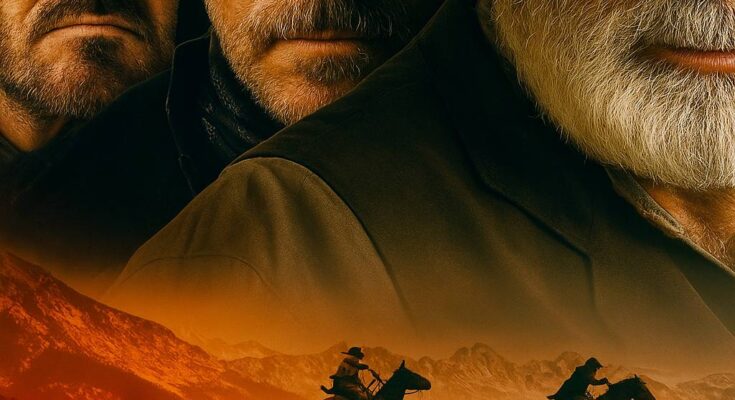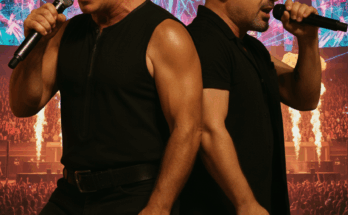“RUST”: A Gritty Tale of Western Vengeance, Hard-Won Redemption, and the Frontier’s Dark Legacy
The Western has always stood as a cornerstone of cinematic storytelling—a genre that captures the lawlessness of the frontier, the harsh beauty of the untamed American West, and the men and women forced to survive in its unforgiving landscapes. From the dusty duels of The Good, the Bad, and the Ugly to the haunting silence of Unforgiven, each Western has added its own chapter to a genre built on blood, honor, and betrayal. Into this legacy now rides RUST, a new film poised to leave a mark with its unflinching portrayal of vengeance, redemption, and the unrelenting shadows of frontier justice.
At its core, RUST is more than just another gunslinger tale—it’s a character-driven story about broken souls, fractured morality, and the violent choices that carve out legacies. Written and directed with a deliberate eye for grit and authenticity, the film strips away the romanticized image of the West and plunges the audience into a world where survival is won only by those willing to confront their darkest selves.
The film follows Harland Rust, a grizzled outlaw haunted by his past crimes, played with raw intensity by Alec Baldwin. Rust is not the archetypal Western hero—he is weary, deeply flawed, and perpetually aware of the sins that have left his soul scarred. When news reaches him that his estranged teenage grandson has been sentenced to hang for an accidental killing, Rust is forced into a role he never sought: protector, mentor, and reluctant redeemer. Determined to save the boy from the hangman’s noose, he embarks on a desperate journey across the frontier, pursued by bounty hunters, corrupt lawmen, and the ghosts of his own past.
The narrative sets itself apart by intertwining two parallel threads—the external journey of survival through a ruthless and dangerous West, and the internal struggle of a man confronting his own failures as both an outlaw and a grandfather. Each mile of the journey serves as both a physical test of endurance and a spiritual reckoning. Rust must navigate shootouts, betrayals, and shifting alliances, all while attempting to guide his grandson through a moral wilderness as treacherous as the physical frontier.
What makes RUST stand out is its refusal to paint in black and white. There are no pure heroes in this world, only men and women trying to claw their way toward survival or redemption. The grandson himself is portrayed not as an innocent victim but as a young man teetering on the edge of adulthood, capable of both compassion and violence. Rust, for all his desire to save the boy, is forced to confront the possibility that his grandson’s fate may be an extension of his own cursed legacy.
Visually, the film embraces the bleak beauty of the frontier. Sweeping desert landscapes contrast with grimy saloons and lawless towns, creating a setting that is both breathtaking and suffocating. Every frame feels soaked in dust and blood, reminding viewers that the West was never truly golden—it was a place where dreams were crushed as often as they were realized. The cinematography leans into long, tense silences punctuated by explosive violence, evoking the classic style of Sergio Leone while layering on a modern edge of realism.
Thematically, RUST grapples with the timeless questions at the heart of every great Western. What does redemption mean for a man who has spent his life spilling blood? Can vengeance ever be justified when it is driven by desperation rather than honor? And perhaps most importantly, can a man outrun the consequences of his past, or is every action etched permanently into the fabric of his destiny?
The film’s title itself serves as a powerful metaphor. Rust, both the man and the word, suggests decay, erosion, and the passage of time. Just as iron corrodes under years of neglect, so too has Harland Rust’s life been corroded by his violent past. Redemption, if it is possible at all, comes not in the form of heroism but in the willingness to protect someone else from repeating the same mistakes. This is not the West of clear triumphs and victorious endings, but one where every victory is tinged with loss.
Performances anchor the film’s emotional weight. Baldwin delivers a layered portrayal of Harland Rust, capturing both his weary physical presence and the torment of a man who knows he is running out of time to set things right. The young actor playing his grandson provides a compelling counterbalance—reckless yet vulnerable, hardened by circumstances yet still clinging to fragments of innocence. Their relationship becomes the heart of the film, transforming RUST from a story of vengeance into a meditation on legacy and the hope of redemption passed between generations.
The supporting cast deepens the world, populating it with morally ambiguous characters who blur the line between villain and victim. Lawmen chase justice with motives as corrupt as the criminals they pursue, bounty hunters stalk their prey with cold efficiency, and townsfolk struggle to survive in a society where power belongs to the ruthless. Each encounter challenges Rust and his grandson to redefine what justice means in a world where law is often little more than the will of the strong.
Though its bones are firmly rooted in the traditions of the Western genre, RUST also reflects contemporary anxieties. It is a story about cycles of violence, the inheritance of trauma, and the difficulty of breaking free from the shadows of one’s past. In an era where questions of justice and morality are increasingly complex, the film feels timely in its refusal to offer easy answers. It suggests that redemption is never absolute, that vengeance cannot erase loss, and that the true measure of a person lies not in erasing their past but in how they face it.
As the story builds toward its climax, the tension rises not only in the inevitable confrontations of bullets and blood but in the emotional reckoning between Rust and his grandson. The final act forces Rust to confront the ultimate question: is he saving the boy to redeem the boy’s life, or is he doing it to redeem his own? The ambiguity lingers long after the credits roll, haunting viewers with the recognition that in the frontier—as in life—there are no clean resolutions.
In the end, RUST emerges as a powerful addition to the Western canon, not because it reinvents the genre but because it distills its essence into something raw, honest, and unflinching. It is a story that does not glorify violence but examines its costs, a tale that does not promise redemption but insists on the importance of seeking it nonetheless. It strips away the myths of the West to reveal a reality that is both brutal and human, a reality where vengeance is never clean, redemption is never easy, and the frontier’s legacy is forever shadowed by blood.
“RUST: A Gritty Tale of Western Vengeance, Hard-Won Redemption, and the Frontier’s Dark Legacy” is not just a film—it is a reckoning. It forces audiences to look beyond the gunfights and landscapes, into the soul of a man who has lived too long in the shadows and must finally decide whether he will die in them as well.



